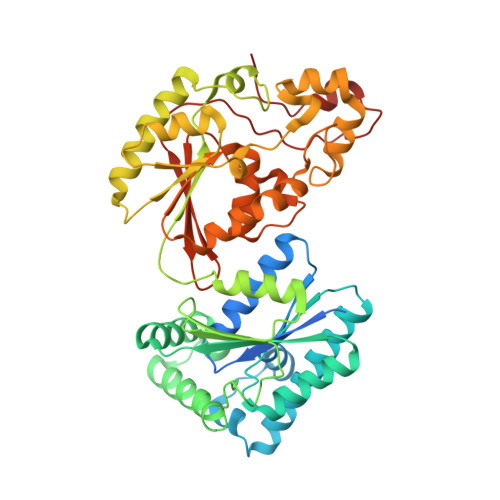A switch in the kinase domain of rat testis 6-phosphofructo-2-kinase/fructose-2,6-bisphosphatase.
Yuen, M.H., Wang, X.L., Mizuguchi, H., Uyeda, K., Hasemann, C.A.(1999) Biochemistry 38: 12333-12342
- PubMed: 10493801
- DOI: https://doi.org/10.1021/bi991268+
- Primary Citation of Related Structures:
3BIF - PubMed Abstract:
The bifunctional enzyme 6-phosphofructo-2-kinase/fructose-2, 6-bisphosphatase plays an essential role in the regulation of glucose metabolism by both producing and degrading Fru-2,6-P(2) via its distinct catalytic activities. The 6-PF-2-K and Fru-2,6-P(2)ase active sites are located in separate domains of the enzyme. The kinase domain is structurally related to the superfamily of mononucleotide binding proteins that includes adenylate kinase and the G-proteins. We have determined three new structures of the enzymatic monomer, each with a different ligand in the ATP binding site of the 6-PF-2-K domain (AMP-PNP, PO(4), and water). A comparison of these three new structures with the ATPgammaS-bound 6-PF-2-K domain reveals a rearrangement of a helix that is dependent on the ligand bound in the ATP binding site of the enzyme. This helix motion dramatically alters the position of a catalytic residue (Lys172). This catalytic cation is analogous to the Arg residue donated by the rasGAP protein, and the Arg residue at the core of the GTP or GDP sensing switch motion seen in the heterotrimeric G-proteins. In addition, a succinate molecule is observed in the Fru-6-P binding site. Kinetic analysis of succinate inhibition of the 6-PF-2-K reaction is consistent with the structural findings, and suggests a mechanism for feedback inhibition of glycolysis by citric acid cycle intermediates. Alterations in the 6-PF-2-K kinetics of several proteins mutated near both the switch and the succinate binding site suggest a mode of communication between the ATP- and F6P binding sites. Together with these kinetic data, these new structures provide insights into the mechanism of the 6-PF-2-K activity of this important bifunctional enzyme.
- Department of Internal Medicine, University of Texas Southwestern Medical Center, Dallas 75235, USA.
Organizational Affiliation:



















